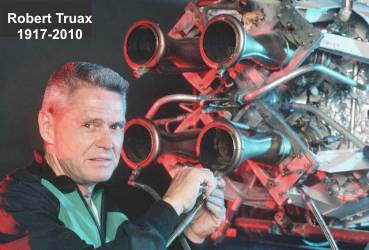|
The unfinished X-3 Project
of Robert Truax
|

|
Robert C. Truax was the former
director of the Advanced Development Division of Aerojet General Corporation.
Before and during World War II, he worked with the U.S. Navy rocket programme.
After retiring from Aerojet General, he began in the early 1970's to study
the possibilities of a small manned sub-orbital re-useable booster constructed
of surplus rocket components. In 1977 was founded the "Project Private
Enterprise".
Finally, his initial version X-3 Volksrocket stands 24 ft tall and is
25 in in diameter. Empty weight is 1.100 lb; fuelled it weighs 3,100 lb.
The propellants (liquid oxygen and kerosene) are pressure fed to four
Atlas vernier engines (Rocketdyne LR 101's) giving a total thrust of 4,000
lb (17.79 kN). A propellant utilization system insures simultaneous depletion
of both propellants. Guidance is provided by HIG-4 floated gyros.
The vehicle is designed to reach an altitude in excess of 50 miles qualifying
the passenger as an astronaut. Burnout will occur at 100,000 ft (30.48
km). Maximum acceleration will be 3 g's. The momentum will carry the rocket,
now slowly tumbling, to peak at an altitude in excess of 50 miles (80.5
km).
When Truax began development, the major problem was with the engines.
The Atlas vernier engine's fuel system was designed to feed a single engine.
Truax had to design a new manifold and gimbal system for four engines.
Up to late 1978, six static tests of the system have been made.
Also tested were the steering servos which gimbal the engine. Engine operation,
at reduced pressure, was checked. This allowed the removal of one of the
two pressurised helium spheres in the original design. |
Truax worked on his
Volksrocket until 2004. Then he lost a competition to be the first non-government
agent to send civilians to space. In the end, Robert Truax did not manage
to qualify his X-3 in such a way that a suborbital flight test could take
place.
Note: The "Skycycle" X-1 and X-2 were vehicles
for the stuntman "Evel" Knievel, for whom Truax had developed a steam propulsion
system. The X-2 had two small nozzles. The X-2 had a larger single nozzle
for higher thrust. Both attempts to overfly the Snake River Canyon have
failed. |
|


|



|
|
Parameter of
propulsion
| Engines |
Thrust
(s.l.)
(kN) |
Isp
(s.L.)
(Ns/kg) |
Thrust
(vac)
(kN) |
Isp
(vac.)
(Ns/kg) |
Flow
rate
(kg/sec) |
Fuel
(kg) |
Burn
time
(sec) |
|
RL-101
|
4.45 |
1952 |
5.56 |
2442 |
2.28 |
- |
- |
|
RL-101 (4)
|
17.79 |
1952 |
22.24 |
2442 |
9.12 |
907.2 |
100 |
|
|

|

|
|

Before static testfire from a Naval barge
|

|
|


|
|


Latest design
|
|